整合
10/2023, Shanghai
A narrative communication space where visitors, including all of us, deeply entrenched in labeling, can come to experience and interact. At the culmination of this space, individuals with different labels engage in dialogue, fostering mutual understanding and reconciliation. The ultimate aim is to provoke contemplation on human labeling and break free from it, altering our perception and utilization of labels, making them tools for facilitating understanding and communication rather than sources of prejudice and stereotypes.
一个叙事交流空间,参观者,包括我们所有人,都可以在这里体验和互动,因为我们深深地被贴上标签。在这个空间的终点,贴着不同标签的人展开对话,促进相互理解与和解。最终目的是引发人们对人类标签的思考,并摆脱标签的束缚,改变我们对标签的认知和利用,使标签成为促进理解和沟通的工具,而不是偏见和刻板印象的来源。
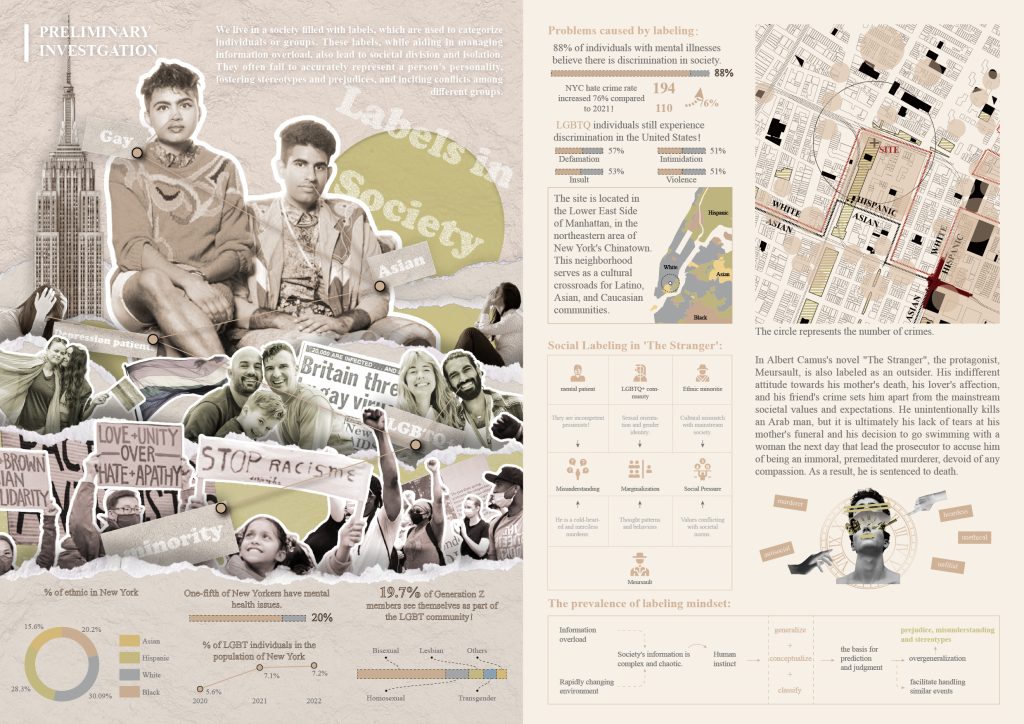
We live in a society full of labels that are used to categorise individuals or groups. While these labels help us to manage the information overload, they also contribute to social fragmentation and isolation. They often do not accurately represent a person’s personality, which fuels stereotypes and prejudices and sparks conflict between different groups.
The Lower East Side of New York is one of the most chaotic parts of the city, where Asians, Latinos and Europeans congregate, and where people are haunted by the labels they carry and often cause conflict over them, and where the dissolution of labels is imminent.
我们生活在一个充满标签的社会,这些标签被用来对个人或群体进行分类。这些标签在帮助我们管理过载信息的同时,也导致了社会的分裂和孤立。它们往往不能准确地代表一个人的个性,从而助长了刻板印象和偏见,并引发了不同群体之间的冲突。
纽约的下东城是纽约最混乱的地方之一,亚裔、拉丁裔和欧裔在此聚集,人们被其所背负的标签所困扰,并时常为此引发冲突,标签的消解迫在眉睫。
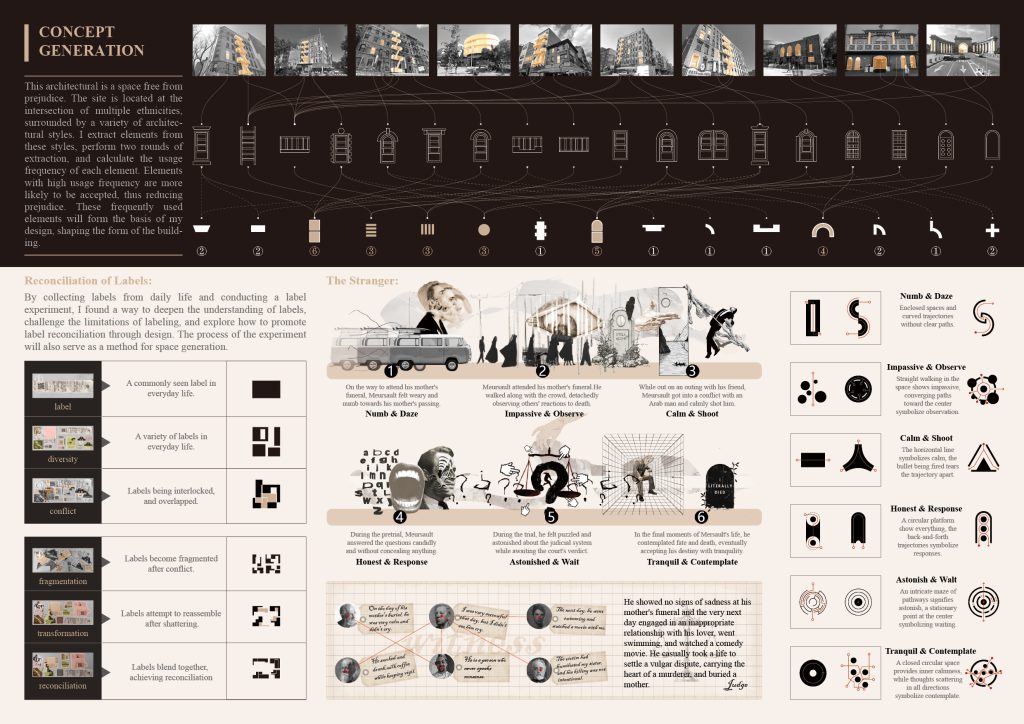
In Camus’s novel The Stranger, the main character, Meursault, is also labelled as an “outsider”. His indifference to the death of his mother, the love of his lover, and the sins of his friends puts him at odds with the values and expectations of mainstream society. His unintentional killing of an Arab man, but ultimately it was his lack of tears at his mother’s funeral and his decision to go swimming with a woman the next day that led the prosecutor to charge him with being an immoral, premeditated, and unsympathetic murderer. As a result, he was sentenced to death. By translating the plot of the novel, the movement of the building is then created.
在加缪的小说《异乡人》中,主人公默尔索也被贴上了 “局外人 “的标签。他对母亲之死、情人之情、朋友之罪的冷漠态度,使他与主流社会的价值观和期望格格不入。他无意中杀死了一名阿拉伯男子,但最终是他在母亲葬礼上没有流泪,以及第二天决定与一名女子去游泳,导致检察官指控他是一个不道德、有预谋、毫无同情心的杀人犯。结果,他被判处死刑。通过对小说情节的转译,建筑的动线则由此产生。
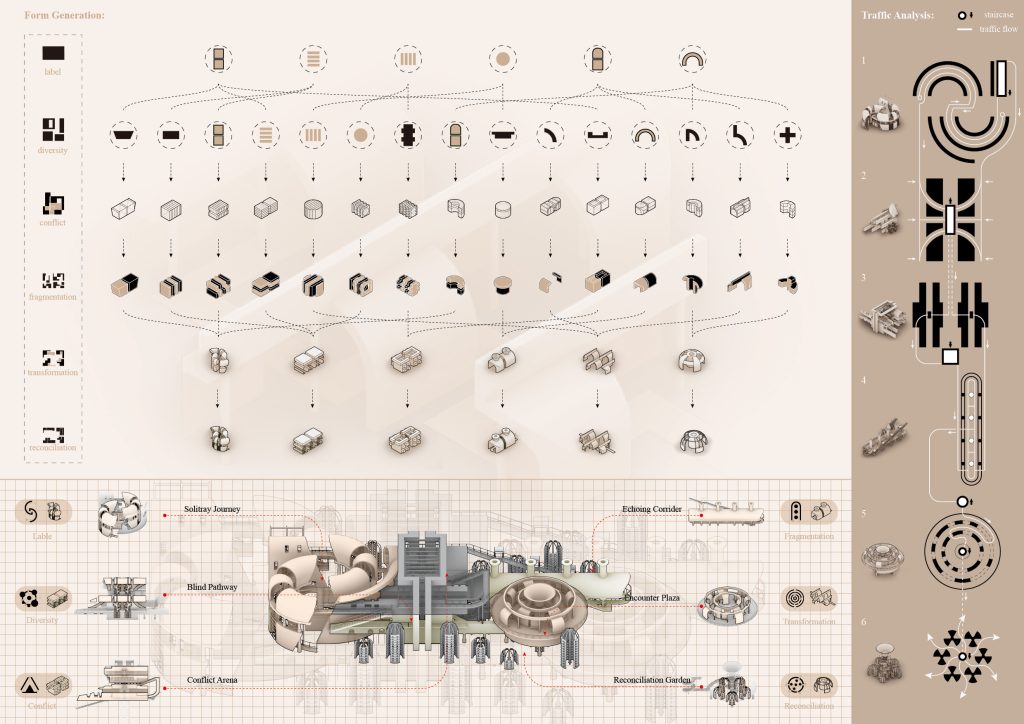
The site is located at a multi-ethnic crossroads and is surrounded by a variety of architectural styles. Elements are extracted from these styles. Elements that are used frequently are more acceptable, thus reducing prejudice. These frequently used elements will form the basis of the design, shaping the shape of the building. In addition, a translation of the label itself will be incorporated into the design as one of the building form’s constituent elements.
场地位于多种族交汇处,周围环绕着各种建筑风格。从这些风格中提取元素。使用频率高的元素更容易被接受,从而减少偏见。这些经常使用的元素将成为设计的基础,塑造建筑的外形。此外,对于标签本身的转译也将融入设计之中,成为建筑形态的构成元素之一。
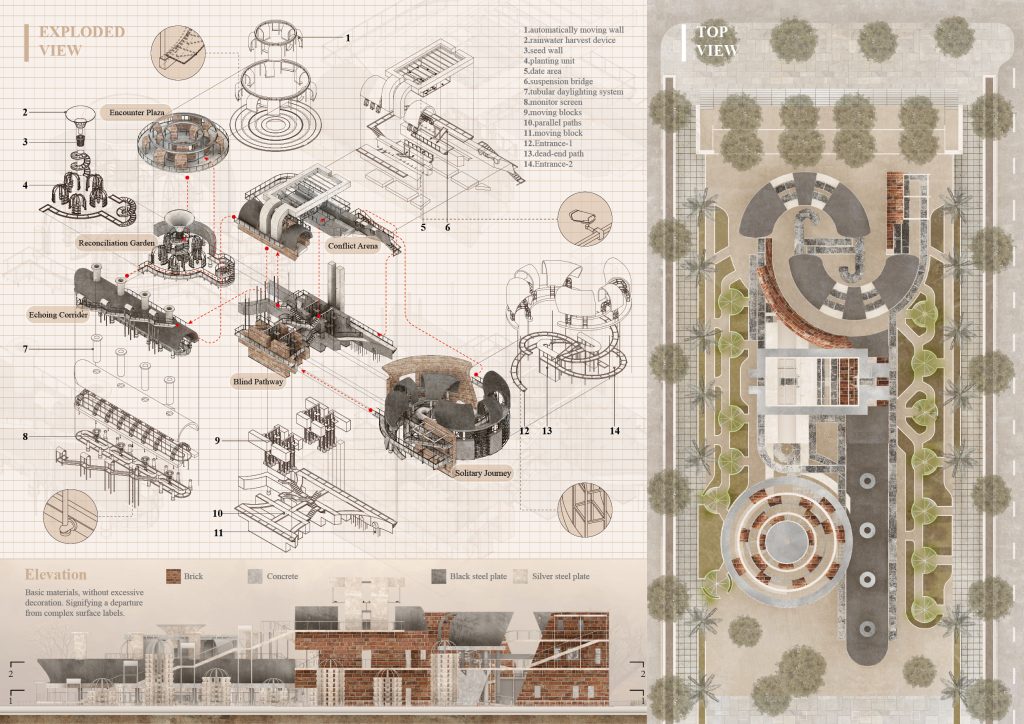
Exploded views of various parts of the building, plan and elevation. The building is divided into 6 different stages, and as the experience progresses, the labels are gradually dissolved and the community will return to peace.
建筑各部分的剖视图和总平立面图。建筑分为6个不同阶段,随着体验的深入,标签逐渐被消解,社区将回归安宁。
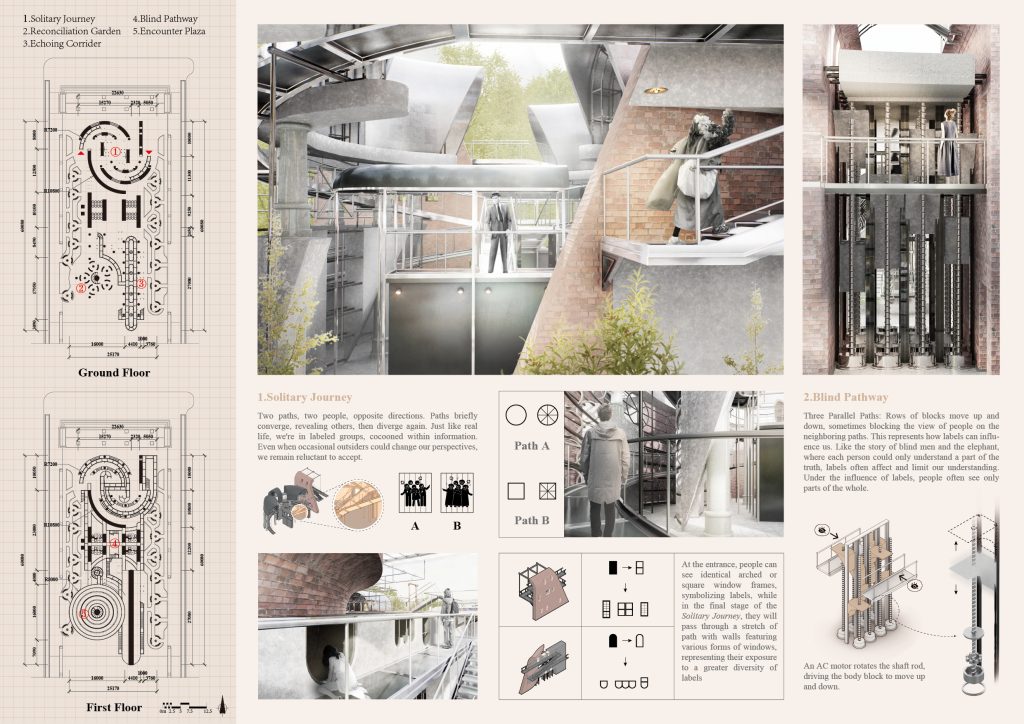
Sectional views and general elevations of various parts of the building.
各层平面图和第一第二阶段的展示。
1,Two paths, two people, opposite directions. Paths briefly converge, revealing others, then diverge again. Just like real life, we’re in labeled groups, cocooned within information. Even when occasional outsiders could change our perspectives, we remain reluctant to accept.
2,Three Parallel Paths: Rows of blocks move up and down, sometimes blocking the view of people on the neighboring paths. This represents how labels can influence us. Like the story of blind men and the elephant, where each person could only understand a part of the truth, labels often affect and limit our understanding. Under the influence of labels, people often see only parts of the whole.
1,两条路,两个人,相反的方向。路径短暂交汇,发现其他路径,然后再次分道扬镳。就像现实生活中一样,我们处在标签化的群体中,被信息所包围。即使偶尔有外来者可以改变我们的观点,我们仍然不愿接受。
2、三条平行小路: 一排排积木上下移动,有时会挡住邻近路径上人们的视线。这代表了标签对我们的影响。就像盲人摸象的故事一样,每个人只能理解真相的一部分,标签往往会影响和限制我们的理解。在标签的影响下,人们往往只能看到整体的一部分。
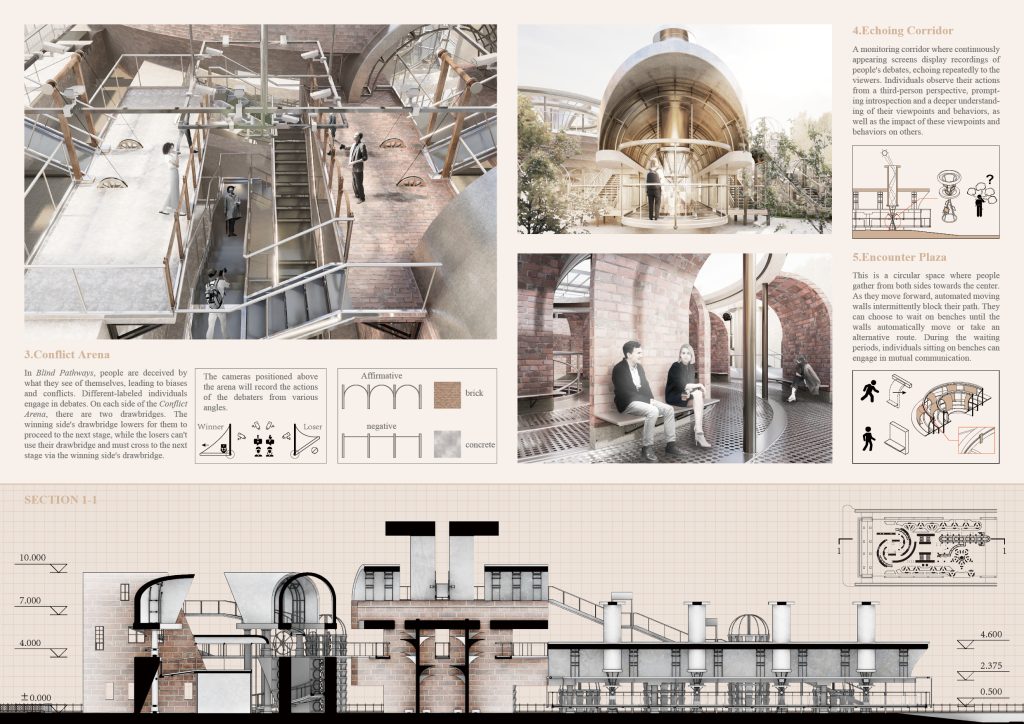
3, In Blind Pathways, people are deceived by what they see of themselves, leading to biases and conflicts. Different-labeled individuals engage in debates. On each side of the Conflict Arena, there are two drawbridges. The winning side’s drawbridge lowers for them to proceed to the next stage, while the losers can’t use their drawbridge and must cross to the next stage via the winning side’s drawbridge.
4, A monitoring corridor where continuously appearing screens display recordings of people’s debates, echoing repeatedly to the viewers. Individuals observe their actions from a third-person perspective, prompting introspection and a deeper understanding of their viewpoints and behaviors, as well as the impact of these viewpoints and behaviors on others.
5, This is a circular space where people gather from both sides towards the center. As they move forward, automated moving walls intermittently block their path. They can choose to wait on benches until the walls automatically move or take an alternative route. During the waiting periods, individuals sitting on benches can engage in mutual communication.
3、在 Blind Pathways 中,人们被自己所看到的自己所欺骗,从而产生偏见和冲突。不同标签的人参与辩论。在冲突竞技场的每一边,都有两座吊桥。获胜方的吊桥放下,他们就可以进入下一阶段,而失败方不能使用自己的吊桥,必须通过获胜方的吊桥进入下一阶段。
4、一个监控走廊,不断出现的屏幕上显示着人们的辩论录音,反复回荡在观众的耳边。每个人都从第三人称的角度观察自己的行为,从而引发反思,更深入地了解自己的观点和行为,以及这些观点和行为对他人的影响。
5、这是一个圆形空间,人们从两侧向中心聚集。当他们向前移动时,自动移动的墙壁会间歇性地挡住他们的去路。他们可以选择在长椅上等待,直到墙壁自动移动,也可以选择其他路线。在等待期间,坐在长椅上的人们可以相互交流。

6, After their conversations, people come together in the Garden of Reconciliation. They choose seeds they like from the seed wall and plant them freely in the garden. They wander through the garden, meeting each other among the intertwining walls, but now they no longer clash. Just as the seeds they planted grow together in the garden, their various labels have also achieved reconciliation. Conflict and division no longer exist. We are all part of this societal garden, and though we once clashed due to different labels, now we grow together.
6、谈话结束后,大家一起来到和解花园。他们从种子墙上挑选自己喜欢的种子,自由地种在花园里。他们在花园中漫步,在交织的墙壁间相遇,但现在他们不再冲突。就像他们种下的种子在花园里一起生长一样,他们的各种标签也实现了和解。冲突和分裂不复存在。我们都是这个社会花园的一部分,虽然我们曾经因为不同的标签而发生冲突,但现在我们共同成长。
